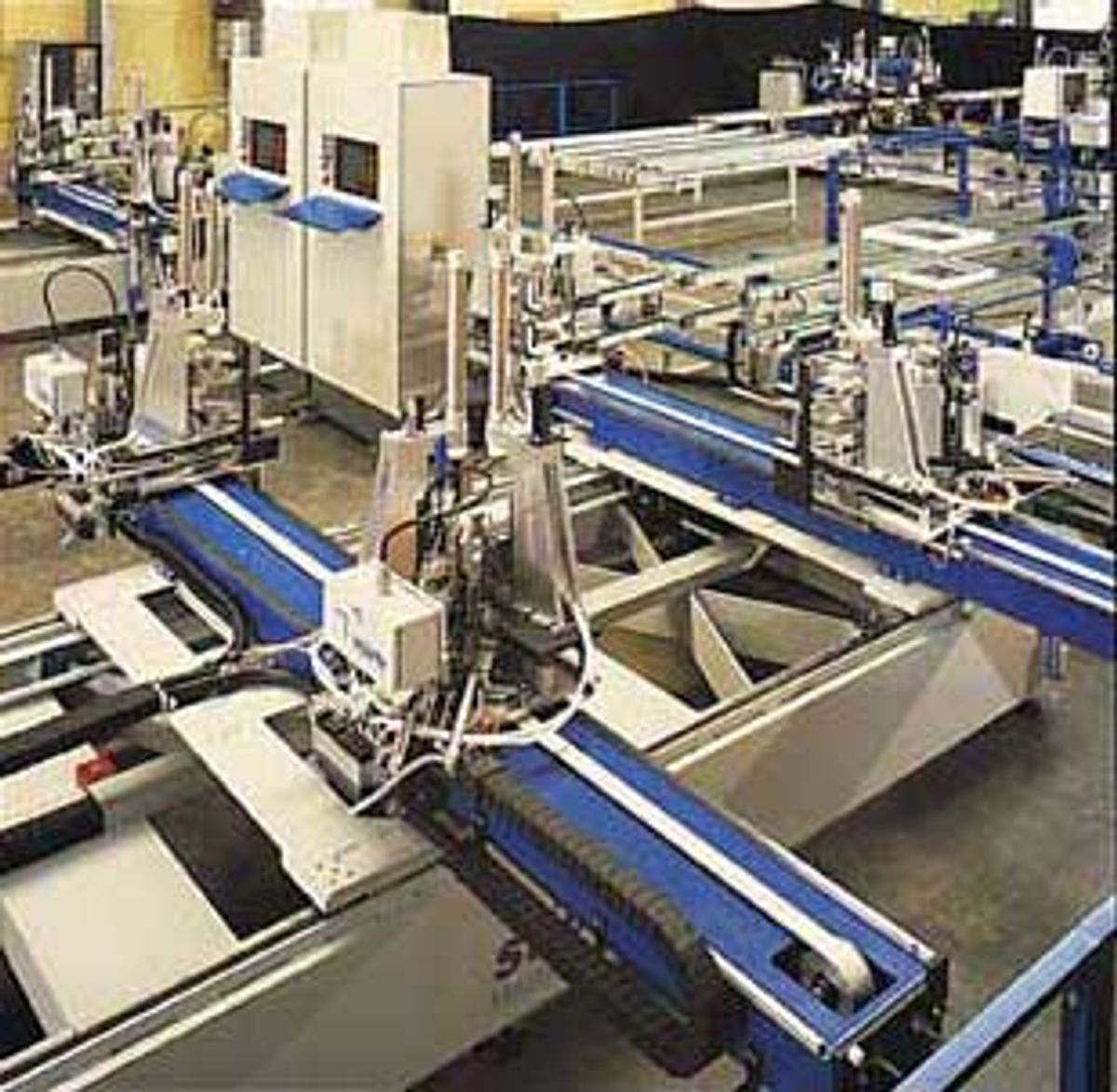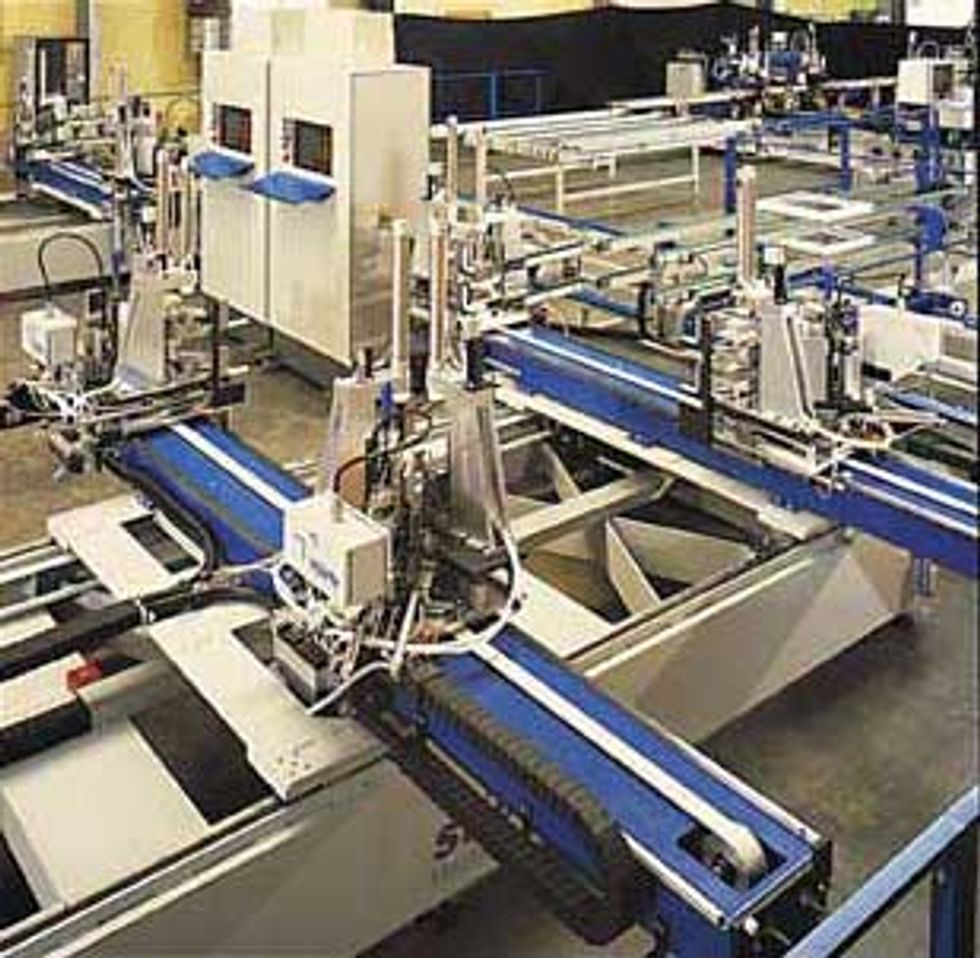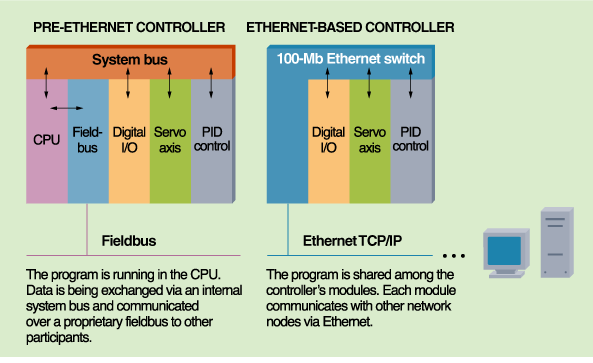Ethernet's Winning Ways
This cost-saving automation backbone is gaining momentum in the factory

This is part of IEEE Spectrum's special report: Always On: Living in a Networked World.
Ethernet networks are winning big in manufacturing automation and process control—and for good reasons: they save money and they simplify operations. By 2003, the market for Ethernet networks that connect the factory to the higher levels of business operations and supply chain management is expected to reach US $3.5 billion, according to Paul Scanlon, senior program manager for GE-Cisco Industrial Networks, a newly formed joint venture in Charlottesville, Va., that designs, installs, and services industrial networks. The company projected that the manufacturing and process control market "will be nearly 100 percent Ethernet within the next four years."
Already, at least 5 percent of the manufacturing and process plants have Ethernet-based systems on the production floor, according to GE-Cisco. While this is still a small percentage, Ethernet capability is becoming such an important factor in the industry that the various industrial fieldbus consortia are redefining their communications protocols to work with both the Ethernet and the Internet [see " Ethernet Wins over Industrial Automation"].
The advantages in using Ethernet-based networks in manufacturing speak for themselves. Not only are they faster than most proprietary systems, but they are also distinctly cheaper. An off-the-shelf board for connecting a PC to an Ethernet costs anywhere from $20 to $50, versus $300 to $900 for a board for a proprietary system. Furthermore, Ethernet connectivity is available at data rates of up to 1 Gb/s, and 10 Gb/s is under development, said Richard H. Caro, a factory automation expert and vice president of ARC Advisory Group, a consulting company in Dedham, Mass. The speediest proprietary systems, by contrast, top out at 12 Mb/s, he noted.
The industry has seen a lot of Ethernet progress in the last two years. The technology has been making inroads particularly in the lowest levels of the manufacturing automation and process control hierarchy, where actuators and sensors, control, and data acquisition call for millisecond decisions. At the higher levels of operations, such as scheduling and supply chain management, where decisions are made typically in a matter of hours, the technology has been in use for several years.
A fringe benefit of the Ethernet's growing acceptance is a wealth of new automation products, each Web-enabled and with its own Internet protocol (IP) address. Among them are programmable logic controllers, power monitors, panel meters, and signal conditioners. The units respond to the seven-layer standard of the Open System Interconnect networking protocol for layer 1 (the physical layer) and layer 2 (the data-link layer). With this capability, plant operators and managers can gain access from anywhere on the Internet to data on plant operations, as well as to units on the factory floor.
Making the Ethernet more attractive for factory automation, too, is its update to a switched Ethernet--that is, the network now allows a direct connection to be established between the sending and receiving nodes. This advance eliminates the collision of messages that can occur in an ordinary Ethernet network where all nodes connect to the same link. In this network, a message from node A to node B will collide with a message sent at the same time from node C to node B. The sending nodes then must stop and re-send their messages at a randomly determined later time, an obvious problem in a factory automation system.
Switched Ethernet directly connects the sending and receiving nodes
Other useful features of the enhanced Ethernet include its ability to support a large number of ports and devices, and its versatility in running on low-cost twisted pair cable, noise-immune optical fiber, or coaxial cable.
One example of a recent Ethernet application that has worked well is a pilot project on the production line for vinyl windows at Willi Stürtz Maschinenbau GmbH in Neustadt/Wied, Germany. The entire production line is based on Ethernet technology: machine tool controllers on the factory floor communicate directly with a higher, supervisory-level network in which the company's enterprise resource planning (ERP) database resides. Instructions for the controllers on the floor are sent from this database.
For example, after a window frame has been welded, the corners must be cleaned of welding debris by a numerically controlled milling machine. To do this, the dimensions of the frame are sent over an Ethernet connection from the ERP database and fed into the control algorithm that guides the milling machine.
The production line uses six prototypes of Ethernet-based JetNode 640 controllers, made by Jetter AG, Ludwigsburg, Germany, a leading manufacturer of industrial controls. A program for the production process is distributed to each controller, and each carries out its part of the program. The units control such actions as measuring the vinyl stock, cutting to size the four pieces for each frame, positioning and clamping the pieces before welding, and controlling the welding temperature.
In this distributed intelligence architecture, each JetNode controller is essentially an Ethernet switch connected to I/Os and servo controllers. One such controller runs a 13-axis milling machine that cleans the four corners of the window frames after the welding [see photo above]. Each JetNode controller has its own IP address and built-in Web server, and all the controllers are interconnected through a 100-Mb/s Ethernet run with a TCP/IP protocol. With this setup, any authorized computer user with a browser anywhere can access the network, send and receive data, and even modify control tasks. Access to the plant takes place via a bridge or router with a firewall.
In contrast, typical factory automation systems often have programmable logic controllers from different vendors, each with its proprietary fieldbus [see illustration below]. Each controller has to be programmed for the tasks at hand, including communication with each other and with the enterprise's software at a higher level. Such a customized setup is labor intensive and time-consuming. Commercial production of JetNode controllers is expected to begin in the first quarter.
Ethernet control schemes such as Jetter AG's are best used in new facilities rather than for retrofitting existing plants, where it may not be worthwhile to replace existing control equipment.
Jetter is a founder of a European industry group, Interface for Distributed Automation (IDA), Blomberg, Germany, whose goal is to develop Ethernet and Web/Internet technologies "as an open distributed intelligence architecture between devices and from the device to the boardroom." The group includes Schneider Electric SA, in Boulogne-Billancourt, France, a manufacturing automation leader; Phoenix Contact GmbH & Co., Blomberg, Germany; and AGE Automation, in Aachen, Germany.
Power monitoring over the Net
Meanwhile new Ethernet-based products for factory automation and related fields have been made available. One is the CM4000, an industrial power monitor from Square D Co., Lavergne, Tenn. In essence, the CM4000 is a Web server. It sends over the Internet such power quality and use data as voltage transients, sags and swells, power demand, power factor, and current and voltage harmonics. It also creates data log files of these and other parameters, which can be accessed over the Internet in real time through an Ethernet communications card that plugs into the monitor.
Also jumping on the Ethernet bandwagon is a package sorting facility that employs two programmable logic controllers (PLCs) on a supervisory level, for managing data, and 35 smaller ones, for sorting and diverting packages off a conveyor belt. The Quantum PLCs, from Schneider Automation Inc. (formerly Modicon Inc.), in North Andover, Mass., are interconnected over a 10-Mb/s Ethernet through which they communicate with each other. For the most part, this installation has replaced proprietary hardware and hardwired systems.
In another example, Newport Electronics Inc., Santa Ana, Calif., has added Ethernet and Web capability to its iSeries line of panel meters and signal conditioners, as well as PID controllers. Through a Web browser, an authorized user anywhere may access an iSeries controller in a manufacturing plant thousands of kilometers away or in the next room to, say, monitor temperature, change set points and alarm points, or make other modifications. What's more, iSeries devices can send warning or alert e-mails to a Web-enabled personal digital assistant or to a cellular telephone compatible with the Wireless Application Protocol.
Powerful networking chips
The brains behind Ethernet- and Internet-enabled equipment are processors with built-in networking capabilities. Manufacturers include large firms such as Motorola, Hitachi, and Infineon, and startups like Netsilicon Inc., in Waltham, Mass. Netsilicon's NET+Works family of chips is built into the Square D and Schneider Automation products. According to the company, the silicon chips contain all the hardware and software necessary to add Ethernet/Internet connectivity to virtually any electronic product, including imaging devices, and industrial automation and data acquisition and test equipment. The software resides in flash memory or ROM.
Process control
Ethernet is also finding its way into real-time process control systems through the Foundation Fieldbus high-speed Ethernet that operates at 100 Mb/s. (This fieldbus was developed and is supported by the Fieldbus Foundation, in Austin, Texas, an organization dedicated to a single international interoperable fieldbus standard.) These high-speed networks connect process feedback loop controllers and measurement and control instruments such as temperature transmitters.
All data transactions are guaranteed a timely delivery to and from the control loops through the use of a so-called publish/subscribe synchronization protocol. High-speed Ethernet networks are expected to "dominate control-level networks for process control in the next five years," ARC Advisory Group's Caro predicted.
To Probe Further
For more information about JetNode Ethernet-based controllers and related topics, visit https://www.jetter.de.
Details on the Net+Works family of NetSilicon's chips are available at https://www.netsilicon.com.

